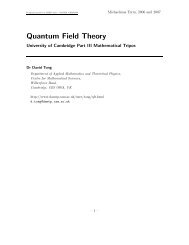CHAPTER 4. THERMODYNAMICS: THE FIRST LAW
CHAPTER 4. THERMODYNAMICS: THE FIRST LAW
CHAPTER 4. THERMODYNAMICS: THE FIRST LAW
You also want an ePaper? Increase the reach of your titles
YUMPU automatically turns print PDFs into web optimized ePapers that Google loves.
orbitals<br />
orbitals<br />
4-17<br />
o<br />
H (C ) = 718.38 kJ/mol<br />
f<br />
(g)<br />
o<br />
H (H ) = 217.94 kJ/mol.<br />
f<br />
o<br />
Then H = 718.38 + 4(217.94)+ 7<strong>4.</strong>85 = 1665.0 kJ,<br />
and therefore the average C!H bond energy is 1665.0/4 = 416.0 kJ/mol.<br />
(g)<br />
As an illustration of how bond enthalpies may be used to estimate enthalpies of formation,<br />
consider the case of benzene;<br />
6C + 3H ! C H .<br />
(gr) 2(g) 6 6(g)<br />
Using the tabulated C=C, C!C, and C!H bond enthalpies, the<br />
formation of benzene from the gaseous atoms as follows:<br />
o<br />
H can be estimated for the<br />
Form 6 C!H bonds = 6 x !413 = !2478 kJ (Note: When bonds<br />
3 C!C bonds = 3 x !348 = !1044 kJ are formed, H is<br />
3 C=C bonds = 3 x !615 = !1845 kJ negative).<br />
Total bond formation = !5367 kJ.<br />
Then, to obtain the enthalpy of formation, we must add the enthalpy changes for the additional two<br />
steps;<br />
o<br />
o<br />
6C 6 6C , H = 6 H (C ) = 6 x 718.38 = 4308 kJ/mol<br />
(gr) (g) f (g)<br />
o<br />
o<br />
3H 6 6H , H = 6 H (H ) = 6 x 217.94 = 1308 kJ/mol.<br />
2(g) (g) f (g)<br />
o<br />
Therefore, fH (C6H 6(g) ) = !5367 + 4308 + 1308 = 249 kJ/mol. Actually, this turns out to be a rather<br />
poor estimate (the experimental value is 83 kJ/mol) because the double bonds in benzene are best<br />
2<br />
described in terms of sp hybridized σ<br />
and delocalized<br />
π<br />
that extend around the<br />
whole molecule. The delocalization causes the bond enthalpy to be considerably larger than that<br />
expected for single and double bonds. This reduction in the bond enthalpy is referred to as<br />
resonance stabilization.<br />
H. Temperature dependence of enthalpy<br />
It is often necessary to know reaction enthalpies at temperatures other than 298 K.<br />
Consider the cycle shown below involving the same reaction at two temperatures T and T .<br />
1 2

















